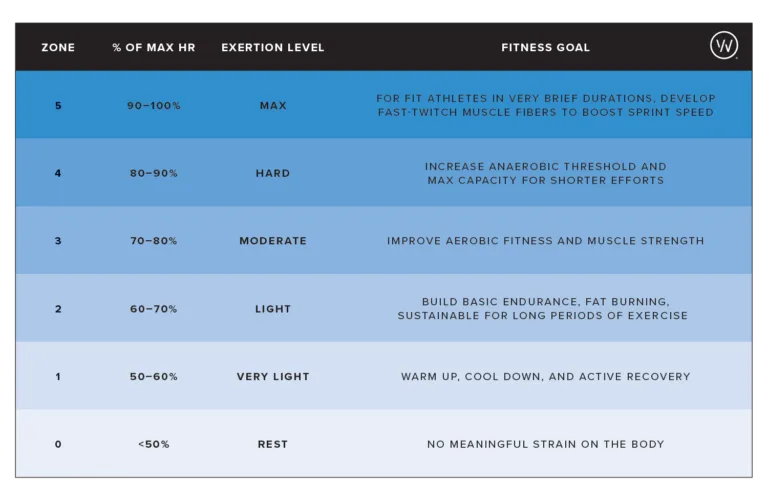Topics
- Article
- Health & Wellness
- Heart Rate
The Truth About the Fat Burning Heart Rate Zone

Fat Burning Heart Rate Zone: There's No Target Heart Rate for Weight Loss
While there is a specific heart rate zone for working out that will technically burn more fat than others, it is not necessary to try to target this HR zone in order to lose weight. Below we’ll explain a bit about how heart rate zones work, what the fat burning HR zone is, what it's useful for, and why when it comes to weight loss and exercise, what really matters is burning calories.
What is the Fat Burning Heart Rate Zone?
When training, athletes often aim to work out at certain percentages of their max heart rate in order to accomplish different goals. The various percentages are referred to as heart rate zones (see graphic below). For the most part, the optimal heart rate for fat burning is generally considered to be about 70% of your max HR. WHOOP uses the heart rate reserve method, which takes into account your max heart rate and resting heart rate over the last 14 recoveries to give you more accurate and personalized HR zones, so as you make progress your HR zones will reflect that.
You can also manually adjust your HR zones to further personalize your experience.
To adjust Max HR & HR Zones
Tap More > App Settings > Activity Settings > Heart Rate Settings

Heart Rate Chart for Fat Burning & Other Fitness Goals Learn More: What is My Target Heart Rate Zone and How Do I Measure It?
How the Fat Burning Zone Works
Your body gets most of its fuel by burning a combination of fat and carbohydrates. The more active you are, the greater percentage of carbs it burns as opposed to fat. Why is this the case? Carbohydrates are a less dense form of energy than fats, which makes them easier to break down. When the intensity level of your exercise increases, your heart rate rises and your body needs energy more quickly, so it turns to the source that can be accessed faster. For this reason, lower intensity workouts burn a higher percentage of fat compared to carbs than higher intensity efforts do.
Heart Rate Zone for Weight Loss?
However, the percentage of fat you’re burning relative to carbohydrates is not what determines weight loss. As stated above, the less active you are, the more fat you burn in relation to carbs. Obviously being inactive isn’t the way to go to lose weight. Your body requires less energy and burns less fuel as activity decreases, so the fat burned is just a larger percentage of a smaller number. We all know exercise promotes weight loss, and what you have to do is burn calories.
Elevate Your Heart Rate to Burn Calories and Lose Weight
In order to lose weight by working out, you must create an energy deficit, which is simply a matter of calories in vs. calories out--burning more than you consume. The more frequently you exercise, and the harder you push yourself while exercising, the more calories you will burn. When you work out in higher heart rate zones, your body burns calories at a faster rate. There’s no reason to limit yourself to the “fat burning heart rate” when weight loss is your intended result. Additionally, more strenuous workouts (including weightlifting) can contribute to losing weight even after you’re done exercising. Your metabolism often keeps working for up to 2-3 hours to repair damage done to your body.
What the Fat Burning HR Zone is Useful For
While there’s no reason to think of it as the best heart rate zone for weight loss, there is still value to working out in the fat burning zone in some cases. In particular, it can be useful for endurance athletes in training and competition. For example, a distance runner who stays in their fat burning HR zone during a race can conserve energy and tap into their quick-to-break-down reserve fuel supply for a burst of speed at the finish. It is also possible to train for much longer durations of time when exercising in this zone.
Track Your HR Zones with the WHOOP Strain Target
WHOOP measures your heart rate 24/7 and quantifies the strain your body takes on each day, and during individual workouts. Every morning, our recovery metric (calculated using heart rate variability, resting heart rate, respiratory rate and sleep) tells you how prepared your body is to take on strain so you'll know hard hard to push yourself when exercising. By tracking your activities with the WHOOP Strain Target, you can see in real time exactly which heart rate zone you’re in in order to meet your fitness goals.
Set Training Goals with Weekly Plan
With Weekly Plan, you can customize how much time you want to spend in each heart rate zone -- whether you're working on endurance or pushing for higher-intensity sessions. With heart rate zone trend views, you can see how you're tracking towards your goals and keep track of your progress over time.